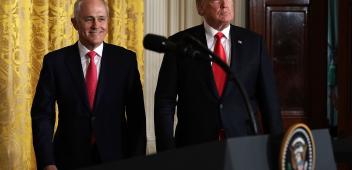'In praise of foreign investment'
Originally published in the Australian Financial Review. This is an edited extract of Andrew Leigh's Lowy Institute Paper Choosing Openness (Photo: fcmarriott/Flickr)

Despite its name, the Chiko Roll does not contain any chicken. Its contents are mostly cabbage and barley, along with other pulped vegetables and a small amount of beef. Its genius lies in the casing – made of egg and flour, and deep fried in oil. Yet the Chiko Roll wasn't just a culinary innovation; it also changed how Australia controlled foreign investment.
In 1972, when tens of millions of Chiko Rolls were being sold annually, the US conglomerate IT&T made a bid to buy the company. The idea of an Australian food icon being sold to Americans caused a backlash in the press and Parliament. As one commentator notes: "The cabinet meeting over the Chiko Roll ... was the beginning of the regulation of foreign investment in Australia."
In recent years, Australians have tended to be more hostile to foreign investment than people in other advanced countries. In 2008, 90 per cent agreed that the federal government has "a responsibility to ensure major Australian companies are kept in majority Australian control". Only 27 per cent support foreign investment in infrastructure. This was the third-lowest level of support out of 12 advanced nations in which opinions were canvassed.
While Australians have become more pro-immigration over time, attitudes to foreign investment seem to have become more disapproving. In fact, there may be no other issue on which economists and the general public disagree more. So, let's dive into the economic case for foreign investment.
Selling iconic firms
A common flashpoint in debates about foreign investment is the sale of iconic firms to overseas buyers. Among the well-known firms now owned by foreigners are Arnott's biscuits, Aeroplane Jelly, Billabong swimwear, Victa lawnmowers, and R.M. Williams boots. Similar concerns have been raised in Britain by the sale of Jaguar to Indian buyers; in the United States by the Chinese purchase of AMC theatres; and in Canada by the sale of Cirque du Soleil to an international consortium.
Critics of these sales often assume that the alternative would have been for the company to continue to exist in local hands. But often, a purchase by foreign buyers is the only way for a business to remain viable. Had Italian firm Fiat not bought US car maker Chrysler in 2009, the firms might never have emerged from Chapter 11 bankruptcy. In other cases, foreign owners bring better corporate strategies, as when US manufacturer Kraft bought Vegemite and turned it into an Australian success.
Foreign investment also helps create opportunities that would not have otherwise existed. Australia's sugar production industry was kick-started in 1855 by the Colonial Sugar Refinery, now known as CSR. Australian manufacturing was boosted when Schweppes opened a bottling facility in 1877, when Kodak set up its first film plant in 1908, when Heinz began canning baked beans in 1935, and when 3M started producing in 1951.
Big investors
Today, foreign firms have established themselves atop a range of Australian industries. In Melbourne, defence firm Lockheed Martin is opening a Skunk Works research facility, focusing on quantum computing, hypersonics, and robotics.
In economic terms, the case for foreign investment is that it fills the gap between domestic savings and domestic investment. In 2016, that gap was $44 billion, about one-ninth of total domestic investment ($400 billion). The gap between domestic investment and domestic savings is called the current account deficit. Over the past decade, Australia's current account deficit has shrunk a little, but it is still the fourth-largest in the world, in absolute terms. Few other countries are as hungry for overseas investment as Australia.
What would happen if we ended all foreign investment? One possibility is that total Australian investment would fall by about one-ninth. In other words, one in nine new roads might not be constructed; one in nine solar farms might not be installed; one in nine buildings might not be erected, and so on.
Higher wages
The other way Australia could cope with the removal of foreign investment would be through higher savings. Savings can come from companies, governments or households, but for argument's sake, suppose that households had to compensate for the absence of foreign investment. To make up for $44 billion of lost foreign investment, the household saving rate would have to almost double. That means the average household would have to increase their savings by $4500.
Either of these outcomes – a one-ninth drop in total investment or a $4500 cut in annual household spending – would have a dramatic impact on the lives of most Australians. A recent study concluded that "restrictions on capital inflow would reduce the wellbeing of Australians". Research in other countries has come to a similar conclusion. For example, an analysis of the United States, the biggest recipient of inbound foreign investment, found that foreign firms paid higher wages, were more innovative, and were more likely to export.
One way to think about the impact of foreign investment on wages is that it raises the ratio of capital to labour in an economy. Nineteenth-century Australia had relatively few workers, but abundant natural resources, so wages were the highest in the world. Allowing foreign investment should bring Australia's rate of return on capital down towards the global rate of return on capital. In this sense, foreign investment may also play a role in offsetting any downward pressure on wages caused by immigration. Migrants lower the ratio of capital to labour. Conversely, foreign investment raises the ratio of capital to labour. So a country that is open to both immigration and foreign investment should be able to sustain its ratio of capital to labour, and therefore its wage levels.



